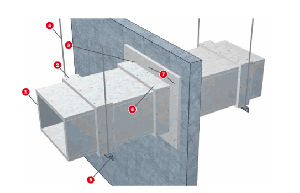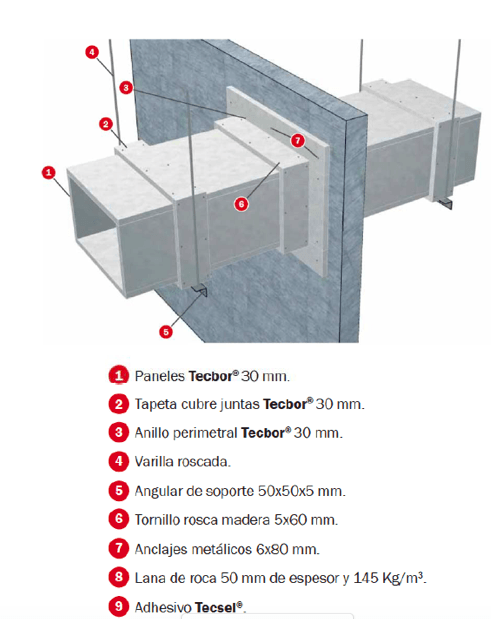
EI-120 ventilation / extraction ducts with 30 mm Tecbor® Board
Actualizado a fecha: 7 February, 2019
Today we are gonna show you one of our most common solutions with Tecbor board, which is the ventilation or extraction ducts with 30 mm Tecbor board.
The first thing that needs to be clarified is when anEI-120 duct should be used. The DB-SI in the Internal Propagation Section in point 3 tells us that:
– The required fire resistance of fire compartments must be maintained at the points where these elements are crossed by installations elements, such as cables, pipes,ventilation ducts, etc., excluding penetrations whose cross section does not exceed 50 cm². For that you can choose one of the following alternatives:
a) Provide an element that, in case of fire, automatically seals the passage section and guarantees at a point a fire resistance at least equal to the one that the element crossed has. For example, an automatic fire damper EI t (i <-> o) where t is the fire resistance time required of the partitioned part, or an intumescent sealing device.
b) Through elements that provide a resistance at least equal to the one of the element traversed, for example, ventilation ducts EI t (i <-> o) where t is the fire resistance time required of the partitioned element crossed.
The use of this type of duct will always be a must when the duct crosses several sectors of fire and whenever it is not possible to have fire doors, as it usually happens in the smoke extraction in case of fire.
Our system does not need a previous sheet conduit, you can make the conduit directly with our material with the following assembly system for EI-120 (which is usually the most usual):
It is also important to mention that when we have to install a conduit with these characteristics, we cannot do it by a False Ceiling EI-120 for two main reasons:
– The ducts are tested by a specific test standard, UNE EN 1366, in which a series of depressions are established that must support it at the same time that it is subjected to the temperature.
– The conduits are required to be tested both vertically and horizontally and withInterior Fire and Outdoor Fire. Moreover they must pass these 4 tests in order to comply with the nomenclature EI-120 (i <-> o) which comes from English (inside <-> > outside), which specifies the DB-SI subjected to the aforementioned depressions.
A false ceiling EI-120 does not work and collapses immediately when the fire is in the plenum or inside a sheet metal duct, besides that it is not tested, nor supports the depressions that the test standard for ducts, the UNE IN 1366.
